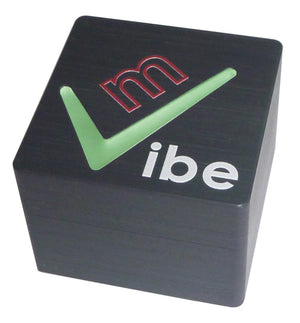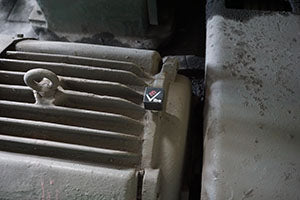







Product Info
mVIBE – wireless vibration and ultrasound meter for industrial application
Description
Software functionality covers
- Possibility for adjusting of a measured vibration parameter to the most of obligatory standards in machine and civil-engineering structures technical condition assessment
- Using of root-mean-square (RMS), peak (amplitude, 0-P) and peak-to-peak (P-P) values for vibration acceleration, velocity and displacement, in arbitrary frequency range in 1 Hz – 25,6 kHz band
- Possible definition of 3 alarm thresholds for vibration level
- Ultrasound leak detection in compressed air installations
- Sound signal for instantaneous exceeding of alarm threshold
- Vibration frequency spectrum plot, resolution of 1Hz
- 4 markers for frequency spectrum plot with markers of harmonic frequencies and sidebands
- Vibration time waveform plot
- 4 markers for a time waveform plot with automatic repeat
- Presentation of numerical values on a plot
- Saving of plot view settings in a graphics file
- Export of frequency spectrum and time waveform to a text file in CSV format
- On-line operation
- Readout of transducer precise sensitivity from measurement device
- Possibility for application testing with the use of smartphone built-in vibration sensors
- Automatic software update
Specification
| Type of sensors | 2 x piezoelectric accelerometers, ceramics PZT, shear mode, YZ direction 3 x MEMS accelerometer, XYZ direction 3 x MEMS gyroscope, XYZ direction 1 x microphone with ultrasonic capability |
| Range of measurements | ±50 g (other as an option) – PZT accelerometer ±16 g (other as an option) – MEMS accelerometer 120 dB SPL (20 Pa) – microphone |
| Frequency range of measured vibrations | PZT accelerometer: -3dB range 0,4 ... 21000 Hz; 10% range 0,8 ... 10500 Hz MEMS accelerometer: 0 ... 1500 Hz Microphone: 2% range 100 ... 10000 Hz; 8dB range 10 ... 20000 Hz and 40 ... 51200 Hz; 14dB range 20 ... 40000 kHz; |
| Type of analogue-digital converter | ΔΣ |
| Definition of analogue-digital converter | PZT accelerometer: 24 bits MEMS accelerometer: 16 bits MEMS gyroscope: 16 bits Microphone: 24 bits |
| Total noise level | PZT accelerometer: 0,8 mgRMS (data for the range ±50 g, fout = 65,536 kHz, frequency range 25,6 kHz) MEMS accelerometer: 3,0 mgRMS (data for range ±16 g, fout = 8,192 kHz, frequency range 1,5 kHz) Microphone: 30 dB SPL (0,6 mPa) (data for frequency range 20 Hz - 8 kHz) |
| Effective sampling frequency (fout) (frequency of updating output ) |
max. 65,536 kHz – piezoelectric accelerometer 8,192 kHz – max. micro-machine accelerometer 131,072 kHz – ultrasonic sensor |
| Chosen filters |
Butterworth low-pass analogue filter, limit frequency |
| Communication interfaces | IEEE802.11b/g/n WiFi, WPA2 frequency range 2,4 to 2,4835 GHz, maximally transmitted power 19.5 dBm@11b, 16.5 dBm@11g, 15.5 dBm@11n |
| Communication protocol | ATC MESbus |
| Operation conditions | Temp -5 to +50°C; humidity: 10..90% RH |
| Level of protection | IP65, dust resistant case, resistant to water jets from any direction (covered microphone placed in a threaded connector) |
| Software | mVIBE, mVIDIA, VIDIA Optional: API, control functions for Matlab, programming functions adjusted to the application |
| Power | Power a built-in battery Li-Ion 3,7V/1200mAh, integrated charger 5V/550mA work time between charging for a new device up to 8h (continuous data transmission) a built-in battery saving mechanisms and protection against overload or a full discharge |
| Installation | external thread M6, included flat magnet holder and measurement pin |
| Geometric dimensions and mass | 40 x 40 x 32 mm, 95 g |
Resources/Download
Please see a manual below. Vibration analytics involves a multitude of disciplines. Do not hesitate to contact us to validate your use case.
mVIBE – wireless vibration and ultrasound meter for industrial application
Description
Software functionality covers
- Possibility for adjusting of a measured vibration parameter to the most of obligatory standards in machine and civil-engineering structures technical condition assessment
- Using of root-mean-square (RMS), peak (amplitude, 0-P) and peak-to-peak (P-P) values for vibration acceleration, velocity and displacement, in arbitrary frequency range in 1 Hz – 25,6 kHz band
- Possible definition of 3 alarm thresholds for vibration level
- Ultrasound leak detection in compressed air installations
- Sound signal for instantaneous exceeding of alarm threshold
- Vibration frequency spectrum plot, resolution of 1Hz
- 4 markers for frequency spectrum plot with markers of harmonic frequencies and sidebands
- Vibration time waveform plot
- 4 markers for a time waveform plot with automatic repeat
- Presentation of numerical values on a plot
- Saving of plot view settings in a graphics file
- Export of frequency spectrum and time waveform to a text file in CSV format
- On-line operation
- Readout of transducer precise sensitivity from measurement device
- Possibility for application testing with the use of smartphone built-in vibration sensors
- Automatic software update
Specification
| Type of sensors | 2 x piezoelectric accelerometers, ceramics PZT, shear mode, YZ direction 3 x MEMS accelerometer, XYZ direction 3 x MEMS gyroscope, XYZ direction 1 x microphone with ultrasonic capability |
| Range of measurements | ±50 g (other as an option) – PZT accelerometer ±16 g (other as an option) – MEMS accelerometer 120 dB SPL (20 Pa) – microphone |
| Frequency range of measured vibrations | PZT accelerometer: -3dB range 0,4 ... 21000 Hz; 10% range 0,8 ... 10500 Hz MEMS accelerometer: 0 ... 1500 Hz Microphone: 2% range 100 ... 10000 Hz; 8dB range 10 ... 20000 Hz and 40 ... 51200 Hz; 14dB range 20 ... 40000 kHz; |
| Type of analogue-digital converter | ΔΣ |
| Definition of analogue-digital converter | PZT accelerometer: 24 bits MEMS accelerometer: 16 bits MEMS gyroscope: 16 bits Microphone: 24 bits |
| Total noise level | PZT accelerometer: 0,8 mgRMS (data for the range ±50 g, fout = 65,536 kHz, frequency range 25,6 kHz) MEMS accelerometer: 3,0 mgRMS (data for range ±16 g, fout = 8,192 kHz, frequency range 1,5 kHz) Microphone: 30 dB SPL (0,6 mPa) (data for frequency range 20 Hz - 8 kHz) |
| Effective sampling frequency (fout) (frequency of updating output ) |
max. 65,536 kHz – piezoelectric accelerometer 8,192 kHz – max. micro-machine accelerometer 131,072 kHz – ultrasonic sensor |
| Chosen filters |
Butterworth low-pass analogue filter, limit frequency |
| Communication interfaces | IEEE802.11b/g/n WiFi, WPA2 frequency range 2,4 to 2,4835 GHz, maximally transmitted power 19.5 dBm@11b, 16.5 dBm@11g, 15.5 dBm@11n |
| Communication protocol | ATC MESbus |
| Operation conditions | Temp -5 to +50°C; humidity: 10..90% RH |
| Level of protection | IP65, dust resistant case, resistant to water jets from any direction (covered microphone placed in a threaded connector) |
| Software | mVIBE, mVIDIA, VIDIA Optional: API, control functions for Matlab, programming functions adjusted to the application |
| Power | Power a built-in battery Li-Ion 3,7V/1200mAh, integrated charger 5V/550mA work time between charging for a new device up to 8h (continuous data transmission) a built-in battery saving mechanisms and protection against overload or a full discharge |
| Installation | external thread M6, included flat magnet holder and measurement pin |
| Geometric dimensions and mass | 40 x 40 x 32 mm, 95 g |
Resources/Download
Please see a manual below. Vibration analytics involves a multitude of disciplines. Do not hesitate to contact us to validate your use case.
mVIBE Basic Kit
- Regular price
- $1,290.00
- Sale price
- $1,290.00
- Regular price
-
Couldn't load pickup availability




